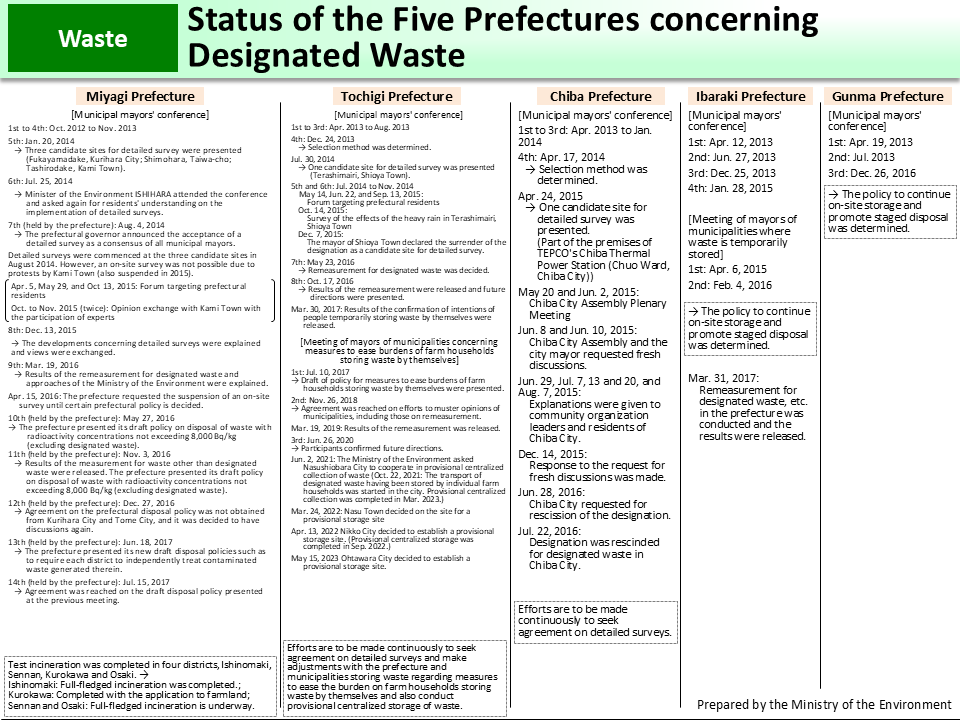Status of the Five Prefectures concerning Designated Waste
Prefectures other than Fukushima Prefecture which are in urgent need to secure Temporary Storage Sites for designated waste (Miyagi Prefecture, Tochigi Prefecture, Chiba Prefecture, Ibaraki Prefecture and Gunma Prefecture) are taking measures in accordance with the circumstances of respective prefectures, based on discussions at municipal mayors' conferences, while ascertaining the current status through the measurement of radioactivity concentrations.
Regarding candidate sites for detailed surveys, Miyagi, Tochigi and Chiba Prefectures followed selection methods determined through discussions at expert meetings and municipal mayors' conferences, and Miyagi presented selected candidate sites in January 2014, Tochigi in July 2014 and Chiba in April 2015. However, detailed surveys have not been conducted due to a failure to obtain understanding of relevant regions.
In the meantime, Miyagi Prefecture determined its policy that each municipality is to make efforts to dispose of contaminated waste with radioactivity concentrations not exceeding 8,000 Bq/kg under the initiative of the prefectural government, and the Ministry of the Environment (MOE) is offering financial and technical support. As part of such efforts, test incineration was commenced sequentially in four districts (Ishinomaki, Kurokawa, Sennan and Osaki) from March 2018 and was completed by July 2019. As of the end of September 2023, waste disposal was completed through full-fledged incineration, etc. in the Ishinomaki district and Kurokawa district, and full-fledged incineration was underway in the Sennan and Osaki districts.
In November 2018, the national government presented a provisional policy for volume reduction and centralized collection of designated waste by the unit of municipality, targeting Tochigi Prefecture and municipalities storing designated agricultural and forestry waste, with the aim of easing burdens of farm households that have been storing designated waste by themselves, while maintaining the basic policy to ultimately develop long-term management facilities. Agreement was reached on the provisional policy. Additionally, it was confirmed that the national government will compile its approach for the selection of provisional storage sites and make efforts to select relevant sites as promptly as possible in collaboration with Tochigi Prefecture and relevant municipalities. In June 2021, the MOE asked Nasushiobara City to cooperate in the provisional centralized collection of designated agricultural waste having been stored by individual farm households and disposal of waste with radioactivity concentrations not exceeding 8,000 Bq/kg after removal of their designation as designated waste. From October 2021 to March 2023, the MOE conducted transportation of designated waste from farm households to the provisional storage site in the city. Out of the transported designated waste, designated agricultural waste whose radioactive concentrations have decreased to 8,000 Bq/kg or lower was incinerated with other general waste after going through procedures for designation removal. In Nikko City, transportation of designated waste to the provisional storage site was completed, and Nasu Town and Ohtawara City respectively decided on a provisional storage site. In this manner, efforts are being made by relevant municipalities.
Chiba Prefecture is also continuing efforts to obtain understanding from the local residents for the implementation of a detailed survey concerning long-term management facilities.
Ibaraki and Gunma Prefectures determined the policies to continue on-site storage and promote staged disposal respectively in February 2016 and December 2016. Based on the determined policies, both prefectures will repair or reinforce storage sites as necessary and will dispose of designated waste whose radioactivity concentrations have reduced to 8,000 Bq/kg or lower at existing disposal facilities in a staged manner.
- Included in this reference material on March 31, 2016
- Updated on March 31, 2024

